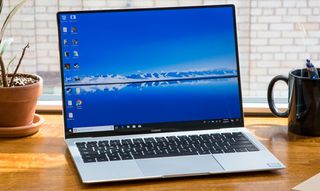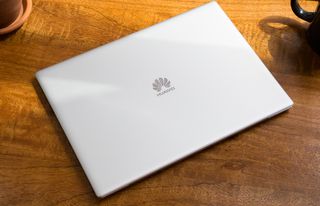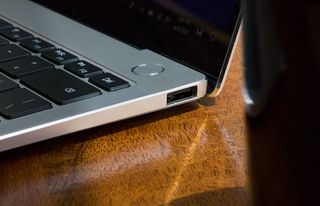Why I Quit the MateBook X Pro and Switched Back to Mac
After 20 years of using — and preferring — Macs, I spent the past month or so on Windows, using the Huawei MateBook X Pro for both work and play. Why? Apple's MacBook Pro designs — with their shallow, unreliable keys — irked me into considering leaving.

In the MateBook X Pro, I found a machine with keys I could trust, a look I already loved — it even confused a friend who was sure it was an Apple laptop — and speedy performance that allowed me to blaze through my work. And while I like the MateBook X Pro, Windows 10 kept pushing me away.
Moving over was pretty easy
For as long as I've lived on Macs, I found the transfer process to be pretty simple. Getting my online accounts natively integrated into Mail and Calendars was as easy as logging in via the Settings app in Windows 10.

I work so much out of Google and Dropbox already that I just smiled as Chrome made it easy. I finished the setup by installing must-have stuff for work, such as OpenVPN and a company-issued license of Microsoft Outlook.
Writing was a breeze
The whole reason I was curious about the MateBook X Pro, and possibly leaving macOS, is that Apple's keyboards have been getting the worst press lately. While I've never been a fan of their shallow depth (which I could get used to, with prolonged use), their butterfly-style switches have been in the news for failing when dust and crumbs get under the keys.
Stay in the know with Laptop Mag
Get our in-depth reviews, helpful tips, great deals, and the biggest news stories delivered to your inbox.
The good news is that a leaked Apple document reveals that Apple's keyboard redesign — initially promoted for reducing noise — also apparently makes the keyboard more reliable by adding a membrane layer that protects the switches from dust.

The Matebook X Pro, on the other hand, has a pretty good keyboard. It easily survived a month of me typing while I snacked on messy snacks, including cheese puffs. Sure, the keys are a little shallow (1.1 millimeters, whereas I'd prefer 1.5 mm), but I got used to that surprisingly fast, and each key gives solid feedback. For comparison, the MacBook Pro's keyboard offers just 0.5 mm of travel.
In a single day, I banged out a 3,518-word feature-length essay on the MateBook X Pro's keyboard. I've already had a brief moment with the 2018 MacBook Pro keyboard, and I think it would take me a while to get used to its shallow keys.
Replacing the basics
Moving to the PC, a lot of the time, has meant leaving the Mac apps I love, such as Tweetbot for Twitter, Things for productivity and Fantastical for managing my calendar. While I have their iOS counterparts on my iPhone, I want apps that sync across my devices.
So I replaced those apps with TweetDeck via Chrome, Google Keep for to-do lists and Google Calendar. While each does the trick — I never fell out of step with any of my work or projects — each also feels utilitarian and mundane, unlike those macOS apps, which are elegantly designed.

I even used iTunes on Windows, even though it's even slower than it is on macOS. While I'm OK with trying out new apps, I'm not leaving my iCloud Music Library, which I've uploaded rare tracks to that aren't on Spotify.
A podcaster's dilemma
I fell short of ignoring my MacBook Pro completely during this trial run. The night before I had to record a podcast, I realized I hadn't investigated audio recording software, and I started frantically looking for an option.
Most sites presented Audacity as my best option, but its user interface is so clogged with buttons and knobs that I didn't think I could learn it in time for the next morning. I wasn't going to try a new piece of software during a live recording with friends in remote locations, and threaten to screw up the process.
MORE: The Best Laptops for Business and Productivity
As I poked around Audacity, I was looking back fondly upon Quicktime, which has a super-simple look and makes it easy to create recordings. And so I cheated on the MateBook X Pro with the MacBook Pro, where I've used the reliably simple QuickTime for sound recording, which gives you a drop-down menu for quality and input.
The next day, when I was recording another podcast with a colleague at my office who uses Audacity, he showed me how most of its settings could be ignored and how all I needed to do was correctly select my microphone.
My funny font problem
Another hiccup came when I had to do some image editing for a Slack group I run. In that moment, I realized I hadn't thought about my need for a PC counterpart to Pixelmator, the hyper-affordable ($29) alternative to Photoshop. Of course, that meant installing a trial run of Adobe Photoshop ($9.99 per month), because I could not, for the life of me, find a similarly priced alternative (Affinity Photo is $49) with a rich feature set, which was annoying.
Once I got Photoshop up and running, I discovered that I was missing my font of choice, Helvetica Neue, which I then imported from my Mac. Although installing the font was as easy as opening the file, my system — especially Chrome — began using the font randomly, replacing a system default.
Googling to find a solution was fruitless, and the entire process just reminded me how Macs, which feature the excellent Font Book app, are more tailored to designers and creatives.
Rude webcam angles
I can't talk about the MateBook X Pro without bringing up its most unique feature: Its webcam is hidden under what appears to be a Function key. To use the webcam, you simply click the key to pop out the camera.

While I applaud Huawei for this clever move for privacy, which also allows for smaller bezels around the MateBook X Pro's display, there's little point in having a webcam when it's placed here. Just ask my colleagues at Laptop, who saw me from the most awkward angles on a web conference call when I was working from home and couldn't help but laugh.
When I was using the laptop from my bed, the camera captured that unflattering angle from under my chin. And when I used the MateBook at my desk, on top of a stack of books I use to keep the screen at the proper height, the camera showed off the space above me, so I had to reach into the air to wave hello.
Display pros and cons
I love, love, love the MateBook X Pro's 14-inch, 3000 x 2000-pixel display. Not only is its 3:2 ratio excellent for reading websites and splitting my screen between two apps, but its superbright, 458-nit screen rendered beautiful images producing 124 percent of the sRGB spectrum. Cuphead, the one PC game I actually play, looked great on this screen during the few rounds of play I got in during the month.

The perks, though, end there. Frustratingly, docking with my Dell 4K monitor and DisplayLink dock at work led to scaling issues. Sometimes, this was just a minor annoyance, with a border running around all application windows, or apps and their overlay messages rendering at slightly larger sizes than they should.
It got worse, though, as the expanding section of the task bar (the hidden items you click to reveal) wouldn't render properly, making some icons inaccessible. The only solution I found was to restart my computer. I've never, ever seen a Mac have such issues. And I find this funny, as the whole point of Windows — or so I thought — was to have a large number of devices that worked well with one another.
Windows being Windows
As productive as I am on the MateBook X Pro, it's still running Windows 10. And I've got nitpicks with that OS.. While I've been able to eliminate Cortana's needy presence, by turning off all of its options and removing that search bar and icon, I felt put upon for even having to do that. Apple puts Siri in the corner — in the menu bar, that is — and it's so easy to ignore up there.
MORE: How to Use Windows 10
Personally, though, I just find Windows 10 to be aesthetically lacking and dull. The blocky design of Universal Windows Platform programs makes them look like they're made in Minecraft, and sticks you with tons of white space (hi, Stride).
Coming back felt right
At the end of my month with the MateBook X Pro, I can definitely say I've warmed to Windows 10, which I've used only at work. Not only does this machine provide a keyboard that I prefer to any model Apple sells, but when I picked up my old, trusty 2012 15-inch MacBook Pro, I remembered that its 4.5-pound weight makes it heftier than the 2.9-pound MateBook X Pro.

Yes, on the night of Tuesday, July 17, after my month with the MateBook X Pro was over, I left that laptop at work and returned to my 2012 MacBook Pro. It's not dead yet, just a little slow, and it's still my favorite laptop. Also, while the MateBook X Pro's keyboard feels better than the 2018 MacBook Pro's, the 2012 MacBook Pro's keys have much more travel and have been going strong for six years now. So, for now, I'll treasure what I have, and hope that the 2018 MacBook Pro keys are as reliable as the leaked reports suggest.
Sure, I missed the MateBook X Pro's fingerprint reader when typing my exhaustively long 1Password password into my 2012 MacBook, but the new Macs feature a Touch ID sensor (though it requires you to ditch physical buttons for the gimmicky Touch Bar).

For now, I'm going to wait to see how the 2018 MacBooks hold up. Sure, their high-end Core i9 models have throttling issues, but if their keyboards are reliable, I don't need to leave the Mac apps I love for a laptop that's not nearly as seamless to use. Just consider how Tweetbot, the best Mac Twitter client, animates GIF images when your cursor browses over them. I saw nothing like that, with any similar care, as I browsed apps in the Windows app store. Tech shouldn't just be helpful; it should be fun — especially when you're spending $1,499 (the price of the MateBook X Pro I'd buy) or more on a laptop.
Credit: Laptop Mag
